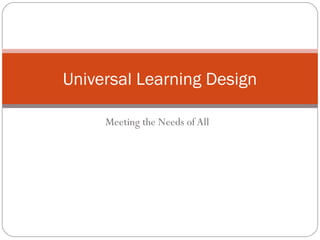
Universal learning design
- 1. Universal Learning Design Meeting the Needs of All
- 2. UDL What is a UDL and what is it? • Simply put UDL stands for Universal Design Learning and it is a set of beliefs for curriculum design that gives everyone the same opportunities to learn. • Also, UDL provides a framework for creating instructional goals, methods, materials, and assessments that has adjustable guidelines that can be specific to each individual needs (Universal Design Learning Center, 2013).
- 3. UDL There are essential parts or principles when it comes to understanding UDL and its focus. First, you must understand that our brain works on three different levels or networks which are Recognition, Strategic, and Affective
- 5. LEARNING DIFFERENCES Recognition learning involves how we collect facts and organize by what we see, hear, and read (Lorain County, 2013) . Scientist research tell us that although many of us share some of same recognition design and view things very much the same way, our recognition networks are different. They come in many different shapes, sizes, and patterns and ultimately these things affect the level of our recognition which accounts for strengths, weaknesses and desire preferences (CAST, 2013).
- 6. LEARNING DIFFERENCES Strategic learning takes place in how we plan and express our ideas. Differences that take place in the strategic network are very noticeable. Some classroom examples would be the way a student process patterns or routines like typing, spelling, and even multiplying. Also, the influences of what learning tool to use can be a strong variation within this network. One last learning difference in this network is some students are top-down processors meaning they can get things almost perfect the first time around and others who get it after significant practice are considered bottom-top processors.
- 7. LEARNING DIFFERENCES Affective learning takes place when we are engaged and motivated through interest. For the most part, we are again very similar in that we all show expression and emotions throughout our bodies. One of the difference that takes place within this network is the level of response to a situation. Some people may experience high anxiety while others low anxiety like on a airplane, in a doctor's office, or even in heavy traffic. These emotions and feelings may not be something you acquired but simply something you were born with.
- 8. INSTRUCTIONAL METHODS Now, here are some instructional methods outlined in a UDL that supports all three forms of learning. For Recognition learning, a great instructional method would be to provide multiple media and formats. This also means to present content or information using various examples for support.
- 9. INSTRUCTIONAL METHODS Regarding Strategic learning, an example of a instructional method that works well is differentiated instruction through flexible modeling and scaffolding.
- 10. INSTRUCTIONAL METHODS Finally, an instructional method that goes well with Affective learning is providing supple instructions and choices of tools that promote learning.
- 11. TECHNOLOGY IN UDL Digital technology is what makes an UDL function and without this component it would be just an idea, but with it, it becomes something tangible and meaningful.
- 12. BENEFITS OF A UDL Implementing an UDL in your instructional planning can and will have many benefits overall. First, as a school, if teachers are using a UDL then the school can ultimately saved money because of not having to provide multiple forms of curriculum and tools. Also, a UDL is logical approach to meeting the laws of the Americans with Disabilities Act and with the Individuals with Disabilities Education Act; this protects the school from possible infractions and violations. And finally, for ethical reasons a UDL offers the benefit of flexible tools and curriculum that can be manipulated to fit all learners depending on their individual needs (Benefits of UDL, 2013).
- 13. TOOLS AND RESOURCES UDL Goal Setter UDL Class Profile Maker. Curriculum Barriers Finder.
- 14. REFERENCES Benefits of UDL. (2013). Retrieved from http://4.17.143.133/udl/BenefitsofUDL12.cfm Center for Applied Special Technology. (2013). Retrieved from http://www.cast.org/udl/index.h tml Center for Applied Special Technology. (2013). Retrieved from http://www.cast.org/teachingsev erystudent/ideas/tes/chapter2_3.cfm Lorain County. (2013). Retrieved from http://www.loraincountyesc.org/region-2-state-support-team/universal- design-learning National Center on Universal Design for Learning. (2013). Retrieved from http://community.ud lcenter.org/forum/topics/what-is-the-role-of- technology National Center on Universal Design for Learning. (2013). Retrieved from http://www.udlcenter .org/aboutudl/udlguidelines/principle2